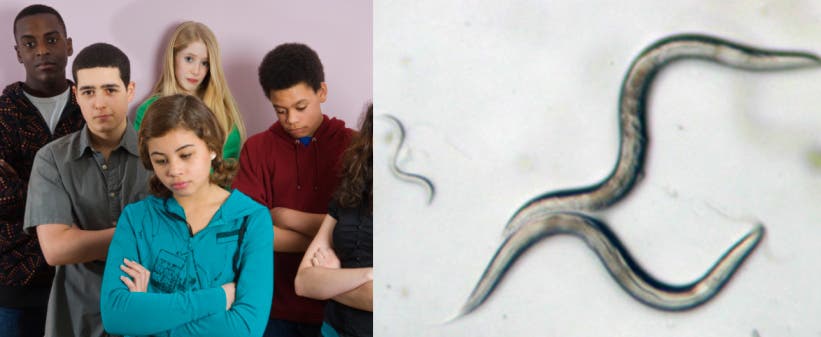According to Salk researchers, young worms and angsty human teens share a surprising number of ambivalent behaviours. Though the common Caenorhabditis elegans worm only has 302 neurons to a teenager’s 100 billion, the Salk team says we can learn a lot about how the brain get structured and changes as we transition to adulthood.
Rebellious worms
To see what behavioural differences exist between young and adult worms, the researchers placed them one at a time at the center of a dish. One one side of the dish, there was a drop of diacetyl, a chemical which smells like ‘buttered popcorn’ and C. elegans simply adores. On the other side was a neutral odor. Over the course of several days, the paths the worms chose were carefully recorded and then analyzed. Results suggest that adolescent worms meandered and took a while before they reached the diacetyl, whereas the adult worms headed straight for it and didn’t lose any time.
See the connection? Morose human teenagers are also incapable of efficiently procuring food. “To watch their behavior, it’s as though they say, ‘Yeah, I know I’m supposed to go over there but I just don’t feel like it,’” says Laura Hale, a collaborative researcher at Salk and first author of the paper.
“Our research shows that, despite having exactly the same genes and neurons as adults, adolescent roundworms have completely different food-seeking preferences and abilities,” says Sreekanth Chalasani, associate professor in Salk’s Molecular Neurobiology Laboratory and senior author of the paper published in eNeuro in January 2017. “It is in adulthood that we finally see the worms become more efficient and competent at finding food.”
The Salk researchers picked the brains of the teenage and adult worms using a now common molecular technique which makes neurons fluoresce when activated by specific odors. The C. elegans worm, for instance, has one of its few neurons dedicated to sensing diacetyl. The worms were exposed to various smells to see which of them caused neurons to fire. For young worms, the AWA neuron pair fired only when a high concentration of diacetyl was waved under their ‘noses’. For adults, however, AWA fired in the presence of subtler concentrations of the popcorn odor.
Three other paired neurons called AWB, ASK, and AWC fired in adults, which suggests adults may be able to respond more complexly to stimuli. Indeed, this seems to be the case, as an experiment showed. When the three secondary neuron pairs were shut down, the adults behaved as erratically as adolescents in their path toward the diacetyl.
What the findings suggest is that teenage worm brains — and likely human teenage brains too — are more plastic, hence govern a more flexible behaviour that can be successful in the face of uncertainty. Adults, on the other hand, have lived long enough to understand which foods are typically available and are less choosy — they’d rather go straight for the food.
“These results support the idea that evolution works by making a juvenile plastic to learn a lot of things; then making an adult tuned to take advantage of that learning,” says Chalasani. “Instead of merely being rebellious, teens—both humans and worms—may just be staying flexible to adapt to an unpredictable world.”










